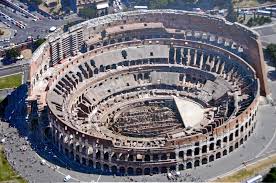Ancient Roman Colosseum History: The Colosseum, originally the Flavian Amphitheatre (Amphitheatrum Flavium), is an elliptical amphitheater in the center of the city of Rome, the largest ever built in the Roman Empire.
Ancient Roman Colosseum History
It was considered to be one of the greatest works of Roman architecture and Roman engineering. To this day the Roman Colosseum remains one the most talked about buildings from the ancient Roman era.

Roman Colosseum facts
Its construction started between 70 and 72 AD, under emperor Vespasian and was completed in 80 AD under Titus, with further modifications being made during Domitian’s reign (81-96). The name “Amphitheatrum Flavium” derives from both Vespasian’s and Titus’s family name Flavius.
It was built near the site of Nero’s Domus Aurea (Golden House). It got its popular name, the Colosseum, because of Nero’s Colossus, 120 ft. high statue of himself, which was nearby.
Construction and Architecture
In Roman Colosseum History, the Colosseum was originally built encompassing four floors. The first three had arched entrances, while the fourth floor utilized rectangular doorways. The floors each measured between 10.5-13.9 meters (32-42 feet) in height. The total height of the construction was approximately 48 meters (144 feet).

Why was the Colosseum built
The Amphitheater was built of travertine outside, and of tufa and brick in the interior. The main pedestals were built of marble blocks weighing 5 metric tons (11,000 pounds). The total amount of marble needed for the construction measured approximately 100,000 cubic meters. Initially, the huge marble blocks were held together by metal-pins.
However, the pins were soon carried off by thieves and had to be replaced by mortar. The interior was divided into three parts: the podium, the arena, and the caves.

According to the Codex-Calendar of 354, the Colosseum could accommodate 87,000 people, although modern estimates put the figure at around 50,000. They were seated in a tiered arrangement that reflected the rigidly stratified nature of Roman society.
Special boxes were provided at the north and south ends respectively for the Emperor and the Vestal Virgins, providing the best views of the arena. Flanking them at the same level was a broad platform or Podium for the senatorial class, who were allowed to bring their own chairs. The poor and the women (except the imperial families) stood or sat on wooden benches in the fourth tier.
Vomitorium
Vomitorium (plural: Vomitoria) was the name given to the passages which led to the entrance of each numbered division of the Colosseum seating.
A wooden floor covered Subterranean Chambers (Cave) where the gladiators and animals were kept waiting to perform. There were no less than 76 numbered entrances and 4 additional entrances reserved for the Emperor, other VIPs, and the gladiators.
The Colosseum was designed for easy crowd dispersal; the entire audience could exit the building in five minutes.

The Arena measured 79 x 45 sq.mts (237-135 feet) and consisted of wood and sand. (The word “arena” is derived from the Latin arena, which means “sand.”) Nets along the sides protected the audience. The arena was where the games actually took place.
Uses
According to Roman Colosseum History, the Colosseum was used to host gladiatorial shows as well as a variety of other events. The shows, called Munera, were always given by private individuals rather than the state. They had a strong religious element but were also demonstrations of power and family prestige, and were immensely popular with the population.
Another popular type of show was the animal hunt or venatio. Battles and hunts were often staged amid elaborate sets with movable trees and buildings.
Sylvie or recreations
Sylvie or recreations of natural scenes were also held in the arena. Painters, technicians, and architects would construct a simulation of a forest with real trees and bushes planted in the arena’s floor. Animals would be introduced to populate the scene for the delight of the crowd.
Such scenes might be used simply to display a natural environment for the urban population, or could otherwise be used as the backdrop for hunts or dramas depicting episodes from mythology. They were also occasionally used for Executions in which the hero of the story – played by a condemned person – was killed in gruesome but mythologically authentic ways.



